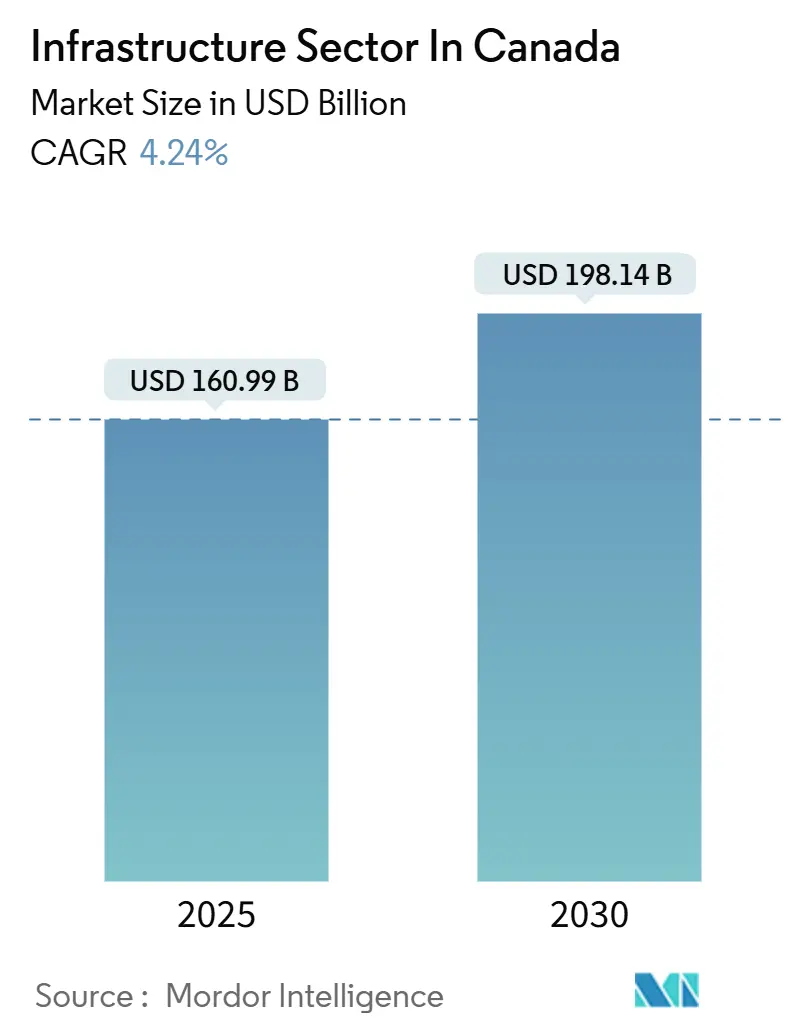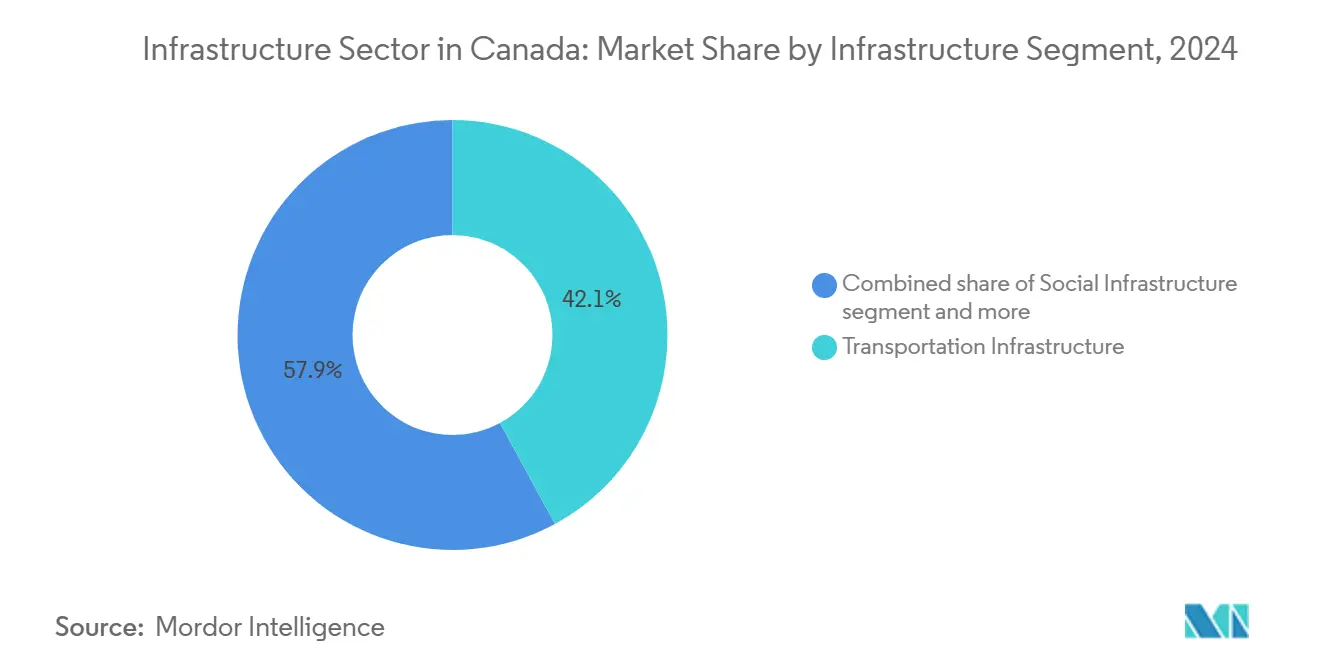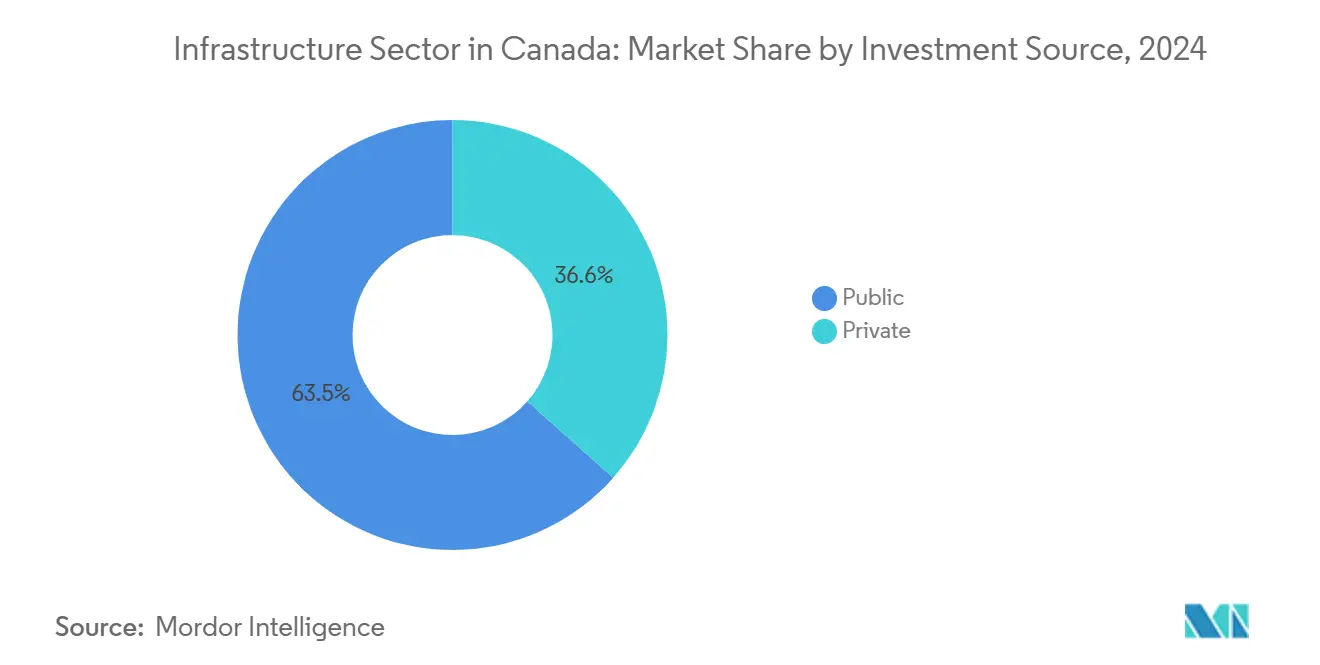
Canada Infrastructure Market Analysis by Mordor Intelligence
The Canada infrastructure market size reached USD 160.99 billion in 2025 and is forecast to advance at a 4.24% CAGR, lifting valuations to USD 198.14 billion by 2030. Federal megaproject funding, demographic pressure on housing and transit corridors, and stringent climate-adaptation mandates converge to expand the Canada infrastructure market while reshaping project design, risk allocation, and procurement models. Federal initiatives such as the CAD 3.9 billion (USD 2.81 billion) Alto high-speed rail line illustrate how Ottawa positions large-scale connectivity as a job creator and decarbonization lever, whereas the CAD 30 billion (USD 21.63 billion) Canada Public Transit Fund links capital outlays to zoning reform that accelerates housing supply near stations. Climate policies, especially the Canada Green Buildings Strategy, drive rapid adoption of low-carbon materials, prefabricated methods, and mass-timber systems that reduce both emissions and labor intensity. Meanwhile, accelerated deployment of broadband backbones and 5G corridors positions digital infrastructure as a co-equal priority alongside roads and rail, reinforcing the long-run growth momentum of the Canada infrastructure market.
Key Report Takeaways
- By infrastructure type, transportation captured 42.1% of Canada's infrastructure market share in 2024 and is advancing at a 6.12% CAGR through 2030.
- By construction type, new construction commanded 78.98% of the Canada infrastructure market size in 2024, whereas renovation output is expanding at a 5.70% CAGR to 2030.
- By investment source, public entities held 78.56% of the Canada infrastructure market size in 2024; private capital records the fastest projected CAGR at 6.50% on the back of public-private partnerships.
- By geography, Ontario led with 39.65% revenue share in 2024, and Alberta posts the highest regional CAGR at 4.68% through 2030.
Canada Infrastructure Market Trends and Insights
Drivers Impact Analysis
| Driver | % Impact on CAGR Forecast | Geographic Relevance | Impact Timeline |
|---|---|---|---|
| Federal "Investing in Canada" spending commitments | +1.2% | National, with concentration in Ontario, Quebec, British Columbia | Long term (≥ 4 years) |
| Rising urban-transit demand in major cities | +0.8% | Ontario, Quebec, British Columbia metro regions | Medium term (2-4 years) |
| Climate-resilient and green-building mandates | +0.6% | National, with early adoption in British Columbia, Ontario | Long term (≥ 4 years) |
| Nationwide broadband & 5G roll-out | +0.4% | National, with priority in rural and remote areas | Medium term (2-4 years) |
| Critical-minerals corridor development in Northern Canada | +0.3% | Northern Ontario, Quebec, Yukon, Northwest Territories | Long term (≥ 4 years) |
| Shift toward modular & off-site construction | +0.2% | National, with concentration in Ontario, British Columbia | Medium term (2-4 years) |
| Source: Mordor Intelligence | |||
Federal “Investing in Canada” Commitments
Ottawa’s multi-year framework reframes infrastructure as an industrial policy that aligns job creation, decarbonization, and regional equity. The flagship CAD 3.9 billion (USD 2.81 billion) Alto high-speed rail corridor alone is slated to create 51,000 construction jobs and offset 90 billion vehicle-kilometers, underlining the catalytic reach of a single megaproject. The Canada Infrastructure Bank adds leverage by channeling CAD 13 billion (USD 9.37 billion) into more than 70 revenue-generating assets, unlocking sizable private matching funds that accelerate project delivery. Performance metrics covering employment, emissions, and Indigenous participation now attach to federal transfers, embedding accountability across the Canada infrastructure market. Provinces synchronize capital plans to capture matching dollars, further widening the project pipeline[1]François-Philippe Champagne, “Alto High-Speed Rail: Federal Funding Announcement,” Infrastructure Canada, infrastructure.gc.ca.
Rising Urban-Transit Demand in Major Cities
Large urban cores adopt transit as a housing and climate lever rather than a congestion remedy. The CAD 30 billion (USD 221.63 billion) Canada Public Transit Fund disburses grants only if municipalities scrap minimum parking rules and up-zone parcels around stations, fusing infrastructure with densification policy. Metro Vancouver’s Surrey-Langley SkyTrain extension, now budgeted at CAD 5.996 billion (USD 4.32 billion), exemplifies cost escalation yet confirms political resolve to expand rail networks that cut per-capita emissions. Toronto, Montréal, and Vancouver have each inked multi-line LRT programs that schedule openings beyond 2028, locking a multi-cycle construction backlog for prime contractors. Transit build-outs also open ancillary opportunities in transit-oriented real estate, micro-mobility, and district energy. The combined momentum lifts the transportation slice of the Canada infrastructure market while anchoring stable revenue streams for operations and maintenance providers.
Climate-Resilient and Green-Building Mandates
The Greening Government Strategy now binds Crown corporations, forcing net-zero alignment by 2050 and driving systematic adoption of low-carbon designs. Updated National Building Code tiers demand air-tightness verification and whole-building energy modeling. Together, these standards trigger a surge in advanced-material uptake, mass timber, thin-wall precast, and vacuum-insulated panels, which compress construction durations and shrink lifetime emissions. Contractors with green-tech credentials gain bid advantages, while laggards risk exclusion from public tenders. The regulatory uplift spreads into private development as lenders prefer green-certified assets, enlarging the addressable pool for the Canada infrastructure market. Over time, energy-positive public buildings and climate-proofed bridges dampen lifecycle costs, validating higher upfront capital spends and solidifying the sector’s growth path[2]Marie-Andrée Renaud, “Greening Government Strategy Guidance for Crown Corporations,” Treasury Board of Canada Secretariat, tbs-sct.canada.ca.
Nationwide Broadband & 5G Roll-out
Digital connectivity has reached parity with roads in public-policy priority, guided by the CAD 3.225 billion (USD 2.32 billion) Universal Broadband Fund aimed at hitting 98% coverage by 2026. TELUS boosts the effort through a CAD 2 billion (USD 1.44 billion) regional expansion that forms part of a CAD 70 billion (USD 50.46 billion) national plan, while Bell activates 3800 MHz spectrum clusters that top 2 Gbps downloads. Rural partnerships like the Eastern Ontario Regional Network layer public–private capital to plug coverage gaps and enable precision agriculture, tele-health, and remote learning. Millimeter-wave pilots in manufacturing hubs illustrate the industrial upside of 5G-powered automation. As digital assets fold into the definition of essential infrastructure, they diversify revenue drivers for the Canada infrastructure market beyond bricks-and-mortar builds and create new recurring-service income streams.
Restraint Impact Analysis
| Restraint | % Impact on CAGR Forecast | Geographic Relevance | Impact Timeline |
|---|---|---|---|
| Skilled-labor shortages & wage inflation | -0.9% | National, with acute impacts in Ontario, Alberta, British Columbia | Short term (≤ 2 years) |
| Lengthy multi-tier regulatory approvals | -0.5% | National, with particular complexity in Quebec, British Columbia | Medium term (2-4 years) |
| Indigenous rights litigation on land use | -0.3% | National, with concentration in British Columbia, Northern territories, resource corridors | Long term (≥ 4 years) |
| Cyber-security risks to OT/SCADA systems | -0.2% | National, with priority focus on critical infrastructure in major urban centers | Medium term (2-4 years) |
| Source: Mordor Intelligence | |||
Skilled-Labor Shortages & Wage Inflation
BuildForce Canada warns that 22% of the residential construction workforce will retire within eight years, while only 228,100 entrants are forecast, stressing every subsector of the Canada infrastructure market. Statistics Canada records a 3.7% year-over-year rise in building costs in Q4 2024, with labor shortages the chief cause. Contractors now ration bids to projects with higher certainty on workforce availability, slowing award cycles. Firms like Pomerleau create proprietary training centers and mount overseas recruitment drives, yet union demographics and immigration bottlenecks keep the talent gap wide. Wage pressure ripples through supplier pricing, potentially eroding the forecast CAGR unless offset by productivity lifts via prefabrication and robotics. Federal youth-employment grants mitigate short-term strain, but structural fixes such as credential reciprocity and skilled-trades immigration streams remain pending[3]Anil Arora, “Building Construction Price Index, Q4 2024,” Statistics Canada, statcan.gc.ca.
Lengthy Multi-Tier Regulatory Approvals
Supreme Court revisions to the Impact Assessment Act blur federal versus provincial roles, injecting ambiguity into project scoping that affects everything from mines to power lines. The Federal Court’s Kebaowek decision elevates Indigenous consultation obligations to require free, prior, and informed consent, often adding years to approval schedules. Ottawa’s proposed Major Projects Office promises to cut designated approval windows to two years, yet coordination with provincial reviews and municipal zoning still drags timelines. Cases such as the Grays Bay Port and Road, where permitting extends to 2027, illustrate the drag on capital deployment. Even provinces streamlining environmental reviews confront legal challenges that reinstate broader assessments. Layered oversight inflates soft costs, raises discount rates, and forces contingency buffers that can curtail the bankability of otherwise attractive projects in the Canada infrastructure market.
Segment Analysis
By Infrastructure: Transportation Drives Connectivity Revolution
Transportation infrastructure generated 42.1% of Canada's infrastructure market size in 2024 and leads growth with a 6.12% CAGR to 2030. The Alto high-speed rail corridor epitomizes this shift toward megaprojects that dovetail emissions abatement, regional economic development, and supply-chain efficiency. Utilities assets such as grid-modernization programs sustain steady expenditure as provinces integrate variable renewables and reinforce climate resilience. Social infrastructure, including hospitals and schools, benefits from pandemic-era stimulus and demographic aging, while extraction infrastructure stabilizes on the back of critical minerals corridors in Northern Ontario and Yukon.
Momentum in transportation reorients contractor capabilities toward public-private delivery models, design-build-finance-maintain structures, and green-bond financing. Quebec’s tramway and Metro Blue Line projects illustrate layered funding structures that combine federal transfers, provincial appropriations, and municipal land-value capture. British Columbia’s Highway 1 flood-proofing upgrades couple mobility with climate adaptation, demonstrating the multidimensional objectives embedded in current tenders. Together, these projects extend backlog visibility for civil works, signaling sustained revenue streams that reinforce the leadership of the transportation tranche within the Canada infrastructure market.

Note: Segment shares of all individual segments available upon report purchase
By Construction Type: Renovation Accelerates Infrastructure Renewal
New construction accounted for 78.98% of Canada's infrastructure market share in 2024, yet renovation spending delivers a faster 5.70% CAGR as aging assets reach replacement thresholds. Nuclear refurbishments, such as the CAD 1.1 billion (USD 0.79 billion) Pickering contract awarded to the Aecon-AtkinsRéalis venture, underscore the complexity and scale of modern renewal projects. Retrofit demand also gains impetus from building-code revisions that obligate envelope upgrades and low-carbon heating conversions across federal and provincial estates.
New builds increasingly feature modular and off-site fabrication aligned with labor-shortage mitigation goals. Ottawa’s CAD 600 million (USD 432.54 million) advanced-construction fund accelerates 3D printing and mass-timber adoption, forecasting 20% cost savings and 22% emissions cuts. The Canada infrastructure market size for modular housing further expands under the CAD 25 billion (USD 18.02 billion) Build Canada Homes financing line aimed at scaling prefabricated facilities. Consequently, contractors diversify into integrated design–manufacture–assemble models, blurring historic boundaries between new-build and renovation supply chains while widening margin potential.
By Investment Source: Private Capital Accelerates Climate Transition
Public entities supplied 78.56% of Canada's infrastructure market size in 2024, reflecting government leadership in nation-building assets, but private funding is projected to grow at a 6.50% CAGR as green-bond frameworks and revenue-backed digital networks multiply. The Canada Infrastructure Bank blends its own CAD 13 billion (USD 9.37 billion)with pension-fund equity, enhancing project bankability while offloading operational risk to experienced concessionaires.
Institutional investors such as the Canada Pension Plan Investment Board co-invest with Global Infrastructure Partners, chasing stable cash flows from regulated clean-energy platforms. Indigenous equity stakes rise via the Indigenous Loan Guarantee Program, evidenced by the CAD 400 million (USD 288.36 million) aggregate guarantee supporting pipeline ownership, aligning reconciliation with returns. Private-sector sophistication now extends to operations, technology licensing, and lifecycle asset management, diversifying revenue models and reinforcing competitiveness across the Canada infrastructure market.

Geography Analysis
Ontario contributed 39.65% of Canada's infrastructure market size in 2024, buoyed by megaprojects including the Eglinton Crosstown LRT and Gordie Howe International Bridge. However, workforce shortages and code harmonization costs present headwinds, pushing authorities to pilot digital permitting that trims municipal approval times. Toronto’s SmartTrack stations integrate fiber-optic corridors to future-proof the transit grid, adding a technology layer to traditional civil works.
Quebec aligns cultural distinctiveness with federal priorities to secure an additional CAD 1.1 billion (USD 0.79 billion) for tramway and metro extensions. Engineering depth nurtured by firms such as EBC and Dragados Canada helps meet aggressive construction schedules, while climate targets induce complementary investments in low-carbon concrete and electric-bus depots. The province also leverages its hydro-electric surplus to anchor green-hydrogen pilot corridors that could become export routes to European markets.
Alberta logs the fastest 4.68% CAGR by pivoting its CAD 8.5 billion (USD 6.13 billion) 2025 transportation budget toward diversification corridors like Fort McMurray–Grande Prairie. Budget allocations cover freight bypasses, smart-highway pilot lanes, and hydrogen refueling nodes, signaling a transition from oil-centric spend to multi-sector resilience. British Columbia’s CAD 195 million (USD 140.58 billion) northwest highway upgrades support critical mineral exports through Prince Rupert, showcasing how remote connectivity underpins national supply-chain security. Atlantic provinces benefit from targeted toll adjustments on the Confederation Bridge and port dredging programs that lower freight costs and attract container trans-shipment. Northern territories receive CAD 194 million (USD 139.85 billion) in tailored funds for climate-adapted airstrips and community fiber spurs, ensuring equitable participation in the Canada infrastructure market.
Competitive Landscape
The Canada infrastructure market displays moderate concentration, with the top five contractors estimated to hold nearly 45% of active backlog. Aecon leads public-sector awards, WSP expands via a USD 1.78 billion acquisition of Power Engineers, and AtkinsRéalis deepens nuclear capabilities through the David Evans Enterprises purchase. Consolidation sharpens focus on end-to-end delivery that spans environmental assessments, design, build, finance, and maintain phases.
Technology becomes a core differentiator as robotics firm Promise Robotics pilots blueprint-reading arms capable of cutting site cycle times by half. Contractors allocate capital toward AI-enabled scheduling, drone surveying, and digital twins that pre-empt cost overruns. Indigenous joint ventures flourish, with 40% of recent clean-energy deals featuring majority Indigenous ownership, supported by equity guarantee schemes that de-risk financing.
Cybersecurity gains prominence because operational technology and SCADA systems face heightened threat vectors. The Canadian Centre for Cyber Security reports rising state-sponsored probing of critical assets, prompting contractors to embed security-by-design protocols in bids. As bidding frameworks weigh ESG and cyber readiness, smaller firms partner with tech integrators to stay compliant, reshaping supply-chain hierarchies within the Canada infrastructure market.
Canada Infrastructure Industry Leaders
-
Aecon Group Inc.
-
PCL Construction
-
EllisDon Corporation
-
SNC-Lavalin Group
-
Graham Construction
- *Disclaimer: Major Players sorted in no particular order

Recent Industry Developments
- August 2025: TELUS confirmed a CAD 2 billion (USD 1.44 billion) broadband expansion in Ontario and Quebec, supplementing its CAD 70 billion (USD 50.46 billion)national program to 2029, following CRTC approval of the wholesale fiber framework.
- July 2025: AtkinsRéalis completed the acquisition of David Evans Enterprises for USD 300 million, boosting Western U.S. transportation and environmental service capacity.
- March 2025: Canada launched BOREALIS, a new agency to advance AI and quantum research, embedded in a broader plan to lift defense spend to 2% of GDP (over USD 6.49 billion).
- January 2025: Aecon Group and AtkinsRéalis secured a CAD 1.1 billion (USD 0.79 billion) early-works contract for refurbishing Pickering Nuclear Generating Station Units 5-8, with an additional CAD 1 billion (USD 0.72 billion)tranche to follow.
Canada Infrastructure Market Report Scope
The infrastructure of a country, society, or organization consists of basic facilities such as transport, communications, power supplies, and buildings, which enable it to function.
The infrastructure sector in Canada is segmented By Infrastructure Segment (Social Infrastructure, Transportation Infrastructure, Extraction Infrastructure, and Manufacturing Infrastructure). The report offers the market sizes and forecasts for the Infrastructure Sector in Canada market in value (USD) for all the above segments.
| Transportation Infrastructure |
| Utilities Infrastructure |
| Social Infrastructure |
| Extraction Infrastructure |
| New Construction |
| Renovation |
| Public |
| Private |
| Ontario |
| Québec |
| British Columbia |
| Alberta |
| Rest of Canada |
| By Infrastructure | Transportation Infrastructure |
| Utilities Infrastructure | |
| Social Infrastructure | |
| Extraction Infrastructure | |
| By Construction Type | New Construction |
| Renovation | |
| By Investment Source | Public |
| Private | |
| By Geography | Ontario |
| Québec | |
| British Columbia | |
| Alberta | |
| Rest of Canada |
Key Questions Answered in the Report
How large is the Canada infrastructure market in 2025?
The Canada infrastructure market size is USD 160.99 billion in 2025 and is projected to rise to USD 198.14 billion by 2030.
What segment leads spending within the market?
Transportation commands 42.1% Canada infrastructure market share in 2024 and records the fastest 6.12% CAGR through 2030.
Which province is growing fastest for new projects?
Alberta shows the highest regional growth at a 4.68% CAGR, driven by an CAD 8.5 billion 2025 transportation budget.
How is private capital participating in Canadian projects?
Private funding is forecast to grow at 6.50% CAGR as the Canada Infrastructure Bank and green-bond frameworks draw pension funds and Indigenous equity partners.
Page last updated on:



